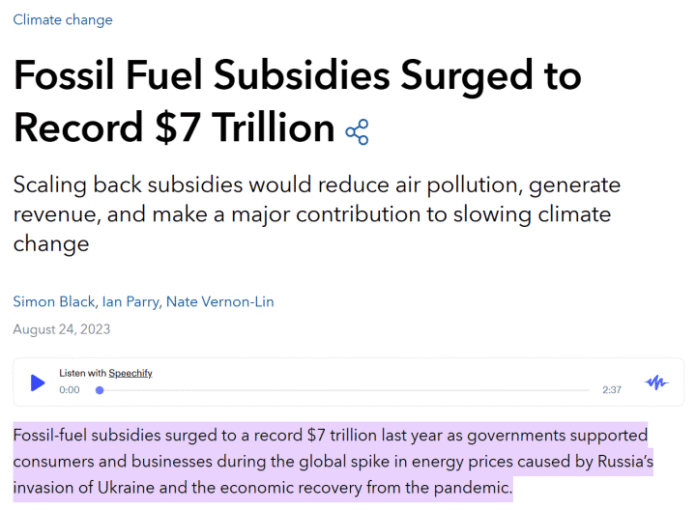Charles Rotter
Dr. Matthew Wielicki’s article, “The $7 Trillion Lie,” is a scathing exposé of what may be one of the most brazen accounting tricks in the climate policy playbook. For years, the International Monetary Fund (IMF) and its ideological allies have floated the claim that fossil fuels receive a jaw-dropping $7 trillion per year in global subsidies. But as Wielicki makes abundantly clear, this figure is not just inflated—it’s fabricated, repackaged propaganda masquerading as economic analysis.
“It is one of the most effective talking points in the climate activist arsenal… and one of the most dishonest,”
Wielicki states plainly. And he’s right. This dubious figure is the linchpin for green energy slush funds, carbon taxes, and regulatory overreach worldwide. It’s the rhetorical battering ram used to justify some of the most sweeping—and costly—interventions in modern economic history.
To understand the sleight of hand at play, Wielicki unpacks how this $7 trillion myth was born. Only a fraction of that amount—less than one-fifth—is actual government spending. “The rest? That’s where the con begins. It’s a clever sleight of hand…” he writes. Indeed, the majority of the number is built on “implicit subsidies”—a bureaucratic fiction concocted by economists to represent hypothetical costs, like the so-called “social cost of carbon.” These are not checks written to ExxonMobil; they are estimates loaded with assumptions and guesswork.
If you want real numbers, Wielicki points readers to the International Energy Agency (IEA) and the U.S. Energy Information Administration (EIA). Their data shows that actual fossil fuel subsidies—the kind you can trace in a budget—amount to $500 to $700 billion per year, and mostly occur in developing nations like Venezuela, Iran, and Indonesia. In these places, fuel subsidies are a matter of economic stability, not environmental sin.
In contrast, Western nations have been pouring taxpayer money into the black hole of green energy. As Wielicki highlights with stark clarity, “solar received 205 times more [federal subsidies] than oil and gas between 2010 and 2019” on a per-unit-of-electricity basis. The graph on page 5 makes this discrepancy obvious, showing that solar receives $70 per MWh, while oil and gas limp along with $0.39 per MWh.

What’s more, the Inflation Reduction Act alone is responsible for over $70 billion in direct subsidies to renewables. This isn’t investment—it’s dependence. As Wielicki quips, “The moment the handouts stop, the industry collapses.” Offshore wind contracts are being scrapped across the East Coast. Siemens and Vestas are hemorrhaging billions. Battery storage is underperforming. Yet the subsidies continue to flow—because the myth of fossil fuel welfare must be sustained.
And herein lies the true motivation for this deception. As Wielicki notes, “Because the $7 trillion claim gives climate bureaucrats and green lobbyists the cover they need. If you can convince the public that fossil fuels are rigging the system with trillions in subsidies, then handing another $100 billion to solar farms that stop working at sundown feels like justice”.
But the reality is far less noble. Fossil fuels, which still supply over 80% of global energy—as the chart on page 6 shows—receive less support per unit of energy than any other sector. They keep the lights on, the hospitals running, and the supply chains moving. And they do it while being demonized by elites who jet to climate conferences to scold the rest of us for driving to work.
What Wielicki delivers here is more than a critique—it’s a forensic audit of ideological corruption masquerading as environmental concern. He methodically dismantles the flimsy scaffolding that supports the $7 trillion narrative and exposes it for what it is: a financial fairy tale designed to redistribute wealth under the guise of planetary salvation.
And the punchline?
“Because the only thing more dangerous than a bad idea… is when you’re forced to fund it”.
This is precisely the kind of myth-busting that’s needed to unmask the technocratic overreach powering the green energy grift. Wielicki’s article doesn’t merely challenge a statistic—it challenges an entire worldview built on manipulating fear and fudging numbers to engineer social and economic transformation.
Let this article be Exhibit A in the case against climate policy by fiat. And remember: when someone tells you fossil fuels are living off your tax dollars, ask them to show the receipts. Odds are, they’re pointing to a spreadsheet full of make-believe.
The riginal article can be found on Dr. Wielicki’s substack.
Related
Discover more from Watts Up With That?
Subscribe to get the latest posts sent to your email.
